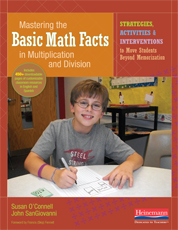Yes, games are a great way to provide fluency practice for learning math facts, but what should we look for when selecting math fact games? We certainly want a game that provides students with repetitive practice with a set of facts. We want a game that is engaging for students so they want to play and will stay engaged with the game for longer periods of time. Many games do both of those things.
It might be more important to think about what we do not want to see when selecting a math fact fluency game. I have two criteria that I avoid.
- Speed
- Elimination
Will the child who can name the sum/product fastest win the game? If so, what is the motivation for those who are just learning their facts? Will they always lose the game? How does this affect their morale and confidence?
If a child does not know the fact, will they be eliminated from the game? If so, then who is left playing the game – those who already know their facts! And who is eliminated – the students for which the game is intended.
A prime example of these two criteria is a game that is still popular in many math classrooms, Around the World. Two students face off against each other. The one to name the answer quicker wins and moves on, the other student is eliminated and slinks back to their seat to draw, read a book, or just feel mortified. How does this game support our fluency goals? How does it build math skills or confidence?
It is time to rethink fluency games to engage all students and eliminate the focus on speed.
Are their games in which students who may be struggling with their facts could actually win the game? It is easier than you might think! Consider the following:
- Students take turns rolling a number cube and multiplying by 8.
- Each student says and records their fact (e.g., 4 x 8 = 32).
- After 3 rolls, the students add their 3 products.
- The student with the greater product is the winner.
Speed is not a factor in this game. It is not about naming the product faster than your partner, it is simply about naming the product. Students might even use a manipulative, drawing, or talk about a number strategy to help them. No one is eliminated, so in every round, a student says and writes three ×8 facts and hears her partner’s facts. Once a winner is found for the round, the partners begin again. This play continues with different partners winning different rounds, but lots of ×8 facts being named. No one is the sole winner. No one is the sole loser. No one is eliminated. All partners are actively engaged throughout.
Or how about a variation of BINGO? Give each student (on a team of 3-4) a blank 5×5 BINGO grid. Each student fills his/her grid with multiples of 8 (0, 8, 16, 24, 32, 40, 48, 56, 64, 72, 80), placing each product anywhere they’d like on their grid and duplicating some of the products to fill all of the spaces on their grid. Place a 0-10 spinner in the center of the group. One player spins, together the players discuss the product, then each covers that product in one place on their BINGO grid (remember all of their grids are different since they placed factors wherever they wanted on their grid). The next player spins and they again discuss, solve, and cover the product on their grid. When a player has BINGO, they uncover all of their BINGO grids and start again to see who might win the next game. Over and over students are seeing and talking about their ×8 facts!
Or maybe give each student a piece of grid paper (centimeter grid paper works well). Students take turns spinning a 1-10 spinner and then multiplying that number by a designated math fact (e.g., ×8). The student then traces an area model of the fact on her grid paper, writing the equation (with the product) inside the grid. Players continue to take turns spinning and creating area models until there is no more room for models on their grid paper. The student whose grid paper has the fewest unused squares wins the game!
Rather than trying to have students memorize lots of facts at one time, these games have provided repeated practice with a fact set to allow students to have saturated practice with those facts and gain confidence and fluency.
Tips for supporting fact fluency through games:
- Always begin with understanding before any attention on fluency. Explore patterns and solve problems related to the facts. Talk about connections to other fact sets. Then, move to fluency.
- Chunk the fact sets rather than asking students to master all facts together. Chunking by fact set allows them to think strategically about those facts while providing a chance to become fluent in small chunks and then build on that fluency with the next fact set.
- Revisit previous fact sets. Many simple games can be played with any fact set, so use games they know and like to revisit past fact sets.
- Demonstrate the game with the class before students play with partners. Then, circulate to be sure they understand the rules and can play effectively.
- As they play the game, have students say and write facts whenever possible to support fact retention.
- Provide accuracy tools so students can check their answers as they play. Students might check their partner’s response with a multiplication chart, a drawing, or manipulatives.
- Use math fact game time to (1) informally assess your students’ fluency to see which are automatic, which are strategic, and which still need substantial fluency practice or (2) pull aside a small group of students who need additional support with understanding the facts.
When John SanGiovanni and I wrote our Mastering the Basic Math Facts Books (Heinemann, 2011), we created dozens of fact games that allow students to repeatedly explore and revisit facts through interactive games. What they have in common is their simplicity, their focus on repetition of facts by fact set, and the way in which they engage all students in the fact practice without elimination or a reliance on speed. Each book (Mastering the Basic Math Facts in Addition and Subtraction and Mastering the Basic Math Facts in Multiplication and Division) comes with over 300 pages of downloadable resources including game templates, spinners, and fact cards, along with ideas for introducing each fact set and exploring the number patterns through literature links, problems, and hands-on investigations.
In our latest teacher resource, Math in Practice (Heinemann, 2016), you will find many math fact games in the grades K-3 books. These games don’t require a huge expenditure for supplies and are built around simple materials like dice and spinners, and include many addition/subtraction and multiplication/division activities that focus on both understanding and fluency. We have included downloadable resources to make your life easier (e.g., division spinners are included in grade 3 for all of the basic division fact sets to allow you to quickly and easily engage students in division practice.)
We have many options for math fact fluency. Let’s select those games that deemphasize speed and elimination!



